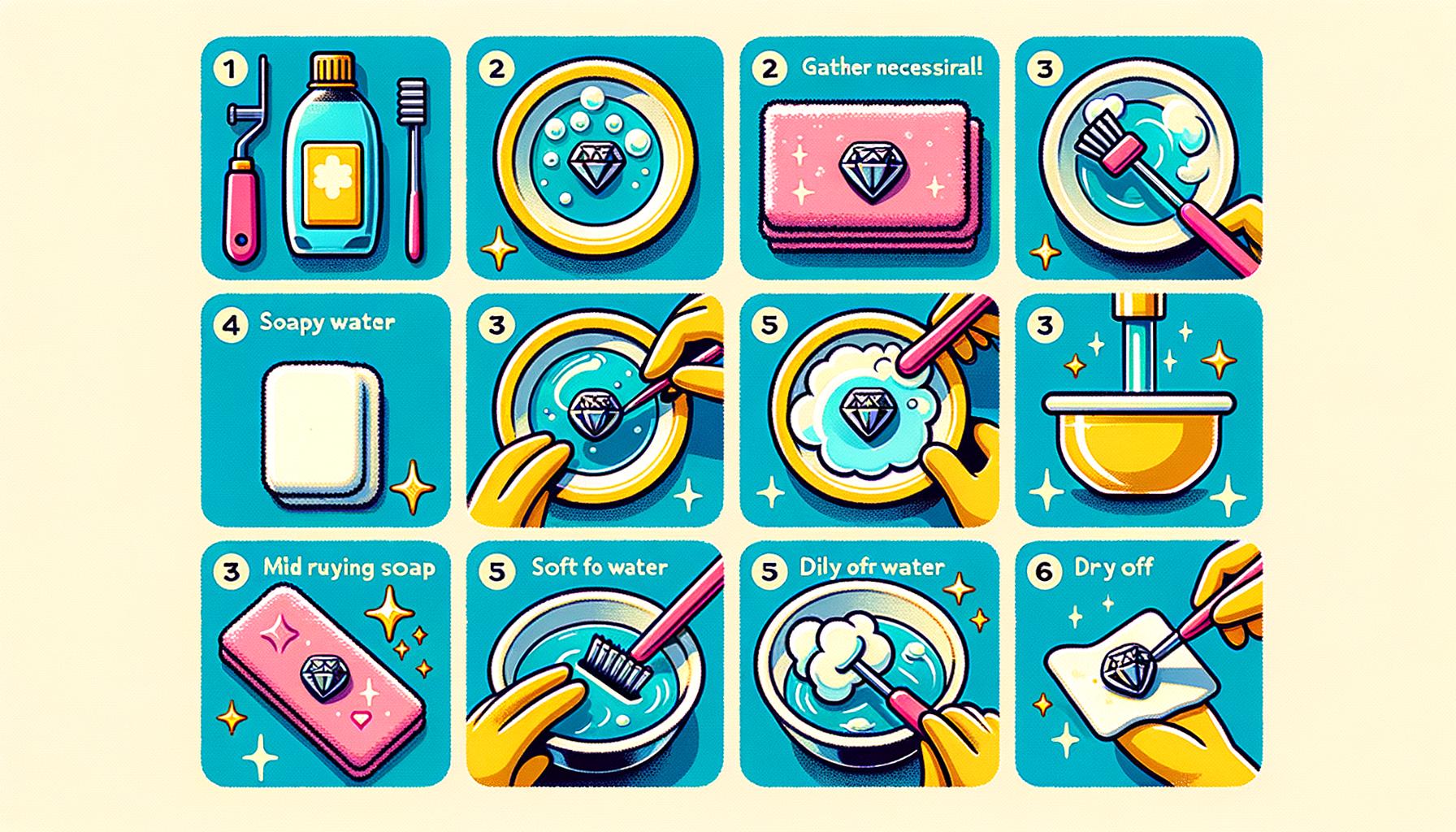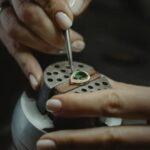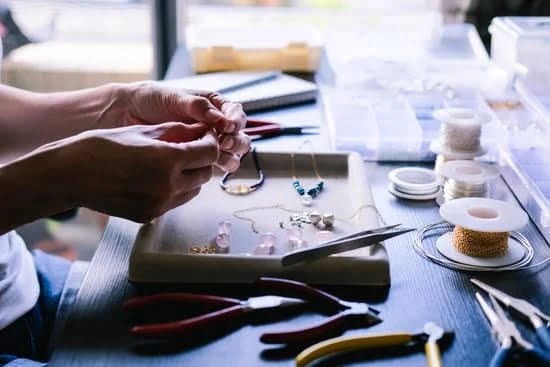Taking care of your jewelry at home is an essential practice that not only ensures your pieces remain stunning but also extends their lifespan. Learning how to clean and polish your jewelry at home can make a significant difference in maintaining its brilliance and avoiding tarnish.
Over time, even the most exquisite pieces can lose their luster due to exposure to everyday elements like dirt, oils, and perspiration. Regular maintenance helps retain the original shine and beauty of your treasured accessories.
One of the primary benefits of keeping your jewelry clean is the prevention of tarnish. Tarnish, which occurs particularly in metals like silver, can dull the appearance of your items and make them look aged and worn out. By implementing routine cleaning habits, you effectively protect your investments from premature aging and unsightly blemishes.
Moreover, clean jewelry does more than just look good; it also feels better against your skin. Accumulated dirt and oils can irritate sensitive skin or cause allergic reactions over time.
In addition to maintaining aesthetic appeal, regular cleaning and polishing safeguard structural integrity. Dirt particles caught in intricate settings or behind gemstones can act abrasively against the metal over time, potentially loosening stones or causing scratches.
A well-maintained piece repeats a cycle of longevity-it shines bright today because it’s cared for regularly, thus guaranteeing it will sparkle for years to come. Through this guide, you’ll discover efficient methods that are both effective and easy on your wallet, employing household items you likely already have on hand without compromising on quality care for even the finest pieces in your collection.
Gathering Your Supplies
When preparing to clean and polish your jewelry at home, gathering the right supplies is essential for achieving professional-looking results. The primary tools you will need include a variety of soft cloths, mild detergent, polishing cloths, and an old toothbrush.
Soft cloths are crucial in avoiding scratches during the cleaning process, while a mild detergent can help to remove dirt and grime without damaging the metal or stones. Polishing cloths are specially designed to bring out the shine in metals like gold and silver, ensuring your pieces look as good as new.
You may also have some effective alternatives at home if you don’t want to purchase specialized products. Common household items such as baking soda, vinegar, and toothpaste can serve as suitable substitutions for commercial cleaners. For example, a paste made from baking soda and water can provide gentle abrasive action ideal for removing tarnish from silver jewelry. Similarly, white vinegar mixed with water can act as a natural cleaner that won’t harm most gemstones or metals.
| Essential Tools/Materials | Household Alternatives |
|---|---|
| Soft Cloths | Non-abrasive kitchen towels |
| Mild Detergent | Baking Soda + Water Paste |
| Polishing Cloths | Toothpaste applied with a soft brush (for metals only) |
| Old Toothbrush | N/A (recommended tool) |
Given these options, it’s clear that how to clean and polish your jewelry at home can be done effectively whether you decide to invest in specific products or use accessible household items. Making sure you have all necessary supplies before you begin not only ensures efficiency but helps protect your treasured pieces from any accidental damage during the cleaning process.
Preparing a Cleaning Solution
When it comes to preparing a cleaning solution for your jewelry, you don’t need to look far for the necessary ingredients. Most of them are likely already in your kitchen or bathroom. Start by getting a bowl and filling it with lukewarm water.
Add a few drops of mild liquid detergent-dish soap works well for this purpose-and ensure it’s adequately mixed into the water. This simple mixture provides an effective base for loosening dirt and grime from a variety of jewelry types.
For those looking into more natural alternatives, baking soda is an excellent choice. You can make a paste by mixing baking soda with just enough water to create a thick consistency. This paste can be applied directly onto metal surfaces or gemstones but be gentle, especially with softer materials like pearls or opals.
Vinegar is another household item that can assist in cleaning jewelry, particularly silver pieces. By immersing the silver items in a vinegar and water solution (let them soak for 15-20 minutes), you can help remove tarnish more efficiently.
Of course, safety should always be paramount when learning how to clean and polish your jewelry at home. Avoid harsh chemicals such as bleach, ammonia, and acetone as they can cause irreversible damage to both metals and gemstones. Always test any homemade solutions on the back or less visible part of the jewelry if you’re uncertain about its reactions. Lastly, rinse each piece thoroughly after cleaning to remove any residue from detergents or other substances used in the process.
Cleaning Different Types of Jewelry Materials
Gold
Gold jewelry, prized for its luster and resistance to tarnish, still needs regular care to maintain its brightness. Knowing how to clean and polish your jewelry at home is key for gold pieces. Begin by soaking your gold items in a solution made from warm water and a few drops of mild detergent.
Let the jewelry sit for about 15-20 minutes to loosen any dirt or oils. Using a soft-bristle toothbrush, gently scrub the surface, especially intricate details that can accumulate grime. Rinse thoroughly with lukewarm water and pat dry with a soft cloth, taking care not to rub too hard which could cause scratches.
For polishing, invest in a high-quality polishing cloth specifically designed for gold. These are usually treated with special chemicals that help eliminate fine scratches and enhance shine. Gently buff the gold item in circular motions until you achieve a bright finish. If desired, homemade polishing solutions like a paste of baking soda and water can also be used. Apply sparingly and remove completely to avoid residue build-up.
Silver
Silver jewelry requires regular cleaning because it is prone to tarnishing when exposed to air and sulfur-containing substances. To restore its natural shine at home, make an effective cleaning bath by lining a bowl with aluminum foil, adding hot water, a tablespoon of baking soda, and salt. Place your silver items in this solution for several minutes; you’ll see the tarnish start to fade thanks to an electrochemical reaction between the aluminum foil and baking soda solution.
After soaking, gently rub any remaining spots with a soft cloth or sponge – never use abrasive materials as they will scratch silver surfaces. Rinse items under cool running water and dry thoroughly with another soft cloth. For additional polish, you can use specialized silver-cleaning creams or pastes found at most jewelers or stores.
Gemstones
Cleaning gemstone jewelry varies due to the diverse properties of different stones such as diamonds versus opals. Diamonds are quite durable but still require careful handling; soak them briefly in warm soapy water (using mild detergent), then scrub delicately with a very soft toothbrush-a diamond’s brilliance depends heavily on being free from grease or oil films.
For softer stones like opals or pearls-never soak-use gentle wiping methods instead: dampen a lint-free cloth slightly with tepid plain water mixed lightly with soap if necessary but minimize exposure as much as possible since these gems are highly porous absorbing liquids which may degrade their appearance over time.
Remember always verifying compatibility before applying any cleaning agent directly onto gemstones – research particular care guidelines tailored towards specific minerals making sure preserving both their visual appeal structural integrity years come ahead.
Polishing Techniques
When it comes to polishing your jewelry, it’s essential to understand the specific techniques tailored to the type of metal or gemstone you’re working with. To achieve a high-quality polish and restore your pieces’ shine, start by selecting the appropriate tools.
For example, microfiber or soft cotton cloths are ideal for most metals as they gently remove dirt without causing scratches. Polishing cloths specifically designed for jewelry can also be highly effective-they often come pre-treated with a polishing compound that enhances the cleaning process.
Investing in good-quality polishing products is crucial if you want professional results at home. Products like silver or gold polishing cloths can make a significant difference in maintaining your jewelry’s luster.
You can also use homemade solutions like a mixture of baking soda and water, which can work wonders on tarnished silver. For gold pieces, consider using toothpaste-not gel-to gently scrub the surfaces; however, always test on a small area first to ensure there’s no adverse reaction.
When dealing with more delicate items such as those adorned with gemstones or intricate detailing, extra caution should be exercised. Rotate your piece slowly under low lighting and inspect it from various angles to identify areas needing focused attention.
Utilizing an old toothbrush can help get into tiny crevices where dirt tends to accumulate but remember to use soft bristles to avoid scratching any surfaces. If you’re concerned about damaging the setting or stone during this process, it’s advisable to consult expert guidance specific to how to clean and polish your jewelry at home before proceeding.
| Tools | Description |
|---|---|
| Microfiber Cloth | Gently removes dirt without scratching surfaces. |
| Old Toothbrush | Helps in cleaning intricate details and crevices. |
| Baking Soda & Water Mix | An effective homemade solution for tarnished silver. |
| Toothpaste | A gentle scrub for gold pieces (not gel type). |
Special Care for Vintage and Heirloom Pieces
Vintage and heirloom pieces require a different level of care compared to modern jewelry due to their age and potential fragility. Cleaning these items at home can be daunting, but with the right approach, you can preserve their beauty and sentimental value without causing damage. One essential tip is to avoid harsh chemicals or ultrasonic cleaners, which can erode the delicate materials often found in older pieces.
When handling vintage jewelry, always start by gently inspecting each piece. Look for signs of loose stones, weakened clasps, or any structural issues that need attention before cleaning. Using a magnifying glass can help you identify problem areas that might not be visible to the naked eye.
Once you’ve assessed that the item is safe to clean, opt for a very mild solution of warm water and a few drops of gentle soap. Dip a soft cloth into this solution and carefully wipe down the jewelry. For intricate designs or hard-to-reach spots, use a soft-bristled toothbrush; however, make sure it’s an old one with extremely soft bristles to prevent scratching.
For particularly delicate items such as those with enamel work or softer stones like opals and pearls, avoid submerging them in water altogether. Instead, take a Q-tip dipped lightly in your soapy water mixture and rub gently over the surface. This method ensures you control the moisture level and prevent potential damage from soaking.
For extra shine without risking harm, consider using specialty polishing cloths designed for antique jewelry rather than generic ones. Knowing how to clean and polish your jewelry at home correctly will help preserve these precious keepsakes for future generations while keeping their timeless allure intact.
Storing vintage and heirloom pieces properly is crucial once they are cleaned. Use padded storage boxes lined with fabric to provide cushioning protection against inevitable knocks or dings.
Suppose you’re dealing with multiple items made from different metals or adorned with various gemstones; it’s best practice to store each piece individually wrapped in acid-free tissue paper or microfibre cloths to avoid tarnishing and scratches from direct contact between items. By employing these meticulous care strategies, you’ll keep your vintage treasures looking magnificent while ensuring they’re ready to be passed down through future family lines.
Storing Your Jewelry After Cleaning
Proper storage of your freshly cleaned jewelry is vital to maintaining its sparkle and preventing damage. Once you’ve learned how to clean and polish your jewelry at home, the next step is ensuring it stays in pristine condition. Here are some essential tips for proper storage.
Firstly, it’s crucial to store each piece of jewelry separately. This will prevent pieces from scratching or tangling with one another. Using a dedicated jewelry box with individual compartments can be very helpful. If a specialized box isn’t available, consider wrapping each item in a soft cloth or placing them in small pouches. For delicate items such as pearl necklaces, lay them flat so the strands don’t get stretched over time.
Another key aspect is choosing the right environment for storage. Moisture is a significant factor that can cause tarnishing, especially for silver pieces. To combat this, keep anti-tarnish strips or silica gel packs inside your jewelry box to absorb any excess moisture. Additionally, avoid storing your jewelry in areas exposed to direct sunlight or extreme temperatures as this could lead to discoloration and degradation of certain materials.
Creating a designated space for different types of jewelry can also extend their life span. Here are some recommendations:
- Necklaces: Hang them on hooks or keep them in separate compartments to avoid tangling.
- Rings and Bracelets: Use slot organizers or padded compartments designed specifically for these items.
- Earrings: Store pairs together either on earring boards or within small sections of an organizer.
By following these steps, you not only learn how to clean and polish your jewelry at home but also ensure it remains protected during storage, maintaining its brilliance and quality over time.
Troubleshooting Common Issues
Even with the best intentions and meticulous care, jewelry can still encounter issues that require troubleshooting. One common problem is persistent tarnish on pieces such as silver or copper jewelry. If your usual cleaning methods don’t seem to be doing the trick, you might need to step up your game by making a more potent cleaning solution.
An effective way to eliminate stubborn tarnish is by creating a paste using baking soda and water. Apply this paste gently with an old toothbrush and rinse thoroughly before polishing with a soft cloth. This method can help restore shine without causing additional damage.
Addressing Loose Stones
Loose stones in your jewelry are not just a minor issue; they pose the risk of losing precious gems altogether. If you notice any wiggling or movement in the stones set in rings, earrings, or bracelets, it’s essential to act promptly.
Using soft wax or dental floss can help temporarily secure loose stones until you can get them professionally tightened. When learning how to clean and polish your jewelry at home, it’s important also to inspect each piece carefully for any vulnerabilities like loose settings.
Dealing With Scratches
Scratches on metal surfaces such as gold and platinum can mar the appearance of even the most beautiful pieces. For minor surface scratches on metal, consider using a jeweler’s polishing cloth that contains micro-abrasives designed specifically for this purpose.
You may also utilize commercial polishing products designed for different metals-just ensure they are compatible with what you’re working on to avoid further damage. Deep scratches might necessitate professional attention; otherwise, regular light polishing after cleaning can maintain your jewelry’s luster while minimizing noticeable imperfections.
Maintaining regular checks and attending promptly to these common issues will help prolong the life of your treasured items while preserving their beauty.
Preventative Maintenance Tips
To keep your jewelry in pristine condition, adopting certain preventative maintenance tips is crucial. These proactive measures will not only help in maintaining the brilliance of your pieces but also in extending their lifespan. One essential practice is to regularly inspect your jewelry for any signs of wear and tear such as loose settings or missing stones. By catching these issues early, you can prevent more significant damage down the line, ensuring that your treasured items remain secure and sparkling.
Another vital habit is to remove your jewelry before engaging in activities that could expose it to harsh chemicals or physical strain. For example, take off rings and bracelets before doing household chores like washing dishes or cleaning with bleach-based products.
Similarly, avoid wearing delicate pieces while swimming, especially in chlorinated pools or saltwater, as these environments can cause irreversible tarnish and degradation of metals and gemstones alike. This simple step can significantly reduce the risk of scratches and tarnish, helping to maintain the integrity of your collection.
Furthermore, getting into a routine of gentle cleaning can work wonders for keeping your pieces looking their best without causing harm. Learning how to clean and polish your jewelry at home using safe methods is invaluable. Regularly wipe down each item with a soft cloth after wearing it to remove any oils or residues that might have accumulated throughout the day.
For deeper cleanses, refer back to tried-and-true home solutions such as mild detergent mixed with water for most metals, or baking soda paste for silver items. Incorporating these practices into your routine will ensure that your jewelry remains vibrant and ready-to-wear whenever you need it.
Lastly, be mindful about where you store your jewelry. Keep each piece separate-in cloth pouches or lined compartments-to prevent them from scratching one another. Humid conditions should also be avoided since they accelerate tarnishing; consider using silica gel packets in storage boxes to help maintain a dry environment. Regular storage evaluations can help identify areas needing improvement to keep all items in optimal condition.
Final Thoughts
Taking the time to clean and polish your jewelry at home can greatly enhance the beauty and longevity of your cherished pieces. Regular maintenance not only helps to retain their brilliance but also prevents issues such as tarnish and scratches. By incorporating simple cleaning routines into your schedule, you can ensure that your jewelry remains in pristine condition for years to come.
Understanding how to clean and polish your jewelry at home is essential for maintaining its original luster. With a few essential tools like soft cloths, mild detergents, and perhaps some household items such as baking soda or vinegar, you can effectively care for various types of jewelry. Special attention should be given to different materials, whether it’s gold, silver, gemstones, or pearls, each requiring its own specific cleaning techniques to avoid any potential damage.
Ultimately, making jewelry care a regular part of your routine will help keep your collection sparkling and well-preserved. Proper storage solutions post-cleaning are just as crucial in avoiding tangling and tarnishing. Whether dealing with vintage pieces handed down through generations or contemporary designs purchased recently, this guide has equipped you with the knowledge needed to address common issues and perform preventive maintenance. Embrace these practices today for long-lasting shine and durability in all your beloved jewelry items.
Frequently Asked Questions
What Is the Best Way to Polish Jewelry at Home?
Polishing jewelry at home can be effectively achieved using a few simple techniques and readily available materials. One of the best ways is to use a microfiber cloth, which is gentle on delicate pieces while effectively removing tarnish and restoring shine.
For more intricate items, a soft-bristled toothbrush can help reach small crevices without scratching. Additionally, using a specialized jewelry polishing cloth that is impregnated with polishing compounds can yield professional-quality results, especially for metals like gold and silver.
What Is the Best Home Remedy for Cleaning Jewellery?
A highly recommended home remedy for cleaning jewelry involves using a mild solution made from warm water and dish soap. This gentle cleanser can break down oils and dirt accumulated on precious metals and gemstones without causing damage.
Soaking the jewelry in this mixture for around 15-20 minutes helps loosen grime, making it easier to remove with a soft brush or cloth. Afterward, rinsing thoroughly with clean water and drying with a soft cloth ensures that all residue is removed, leaving the jewelry looking fresh.
How Do You Clean Jewelry and Make It Shiny Again?
Restoring the shine of your jewelry requires careful cleaning coupled with mindful handling of materials involved in the process. Start by soaking the items in warm soapy water to loosen dirt; then, gently scrub them using a soft toothbrush to get into tight spaces without causing scratches.
For extra luster, you can dip articles like silver into a homemade baking soda paste or use commercial polishes designed specifically for different types of metals and stones. Rinse thoroughly after cleaning to remove any remaining residues, pat dry with a soft towel, and finish by buffing gently with a microfiber or jeweler’s polishing cloth to bring back their radiant shine.

Welcome to my jewelry blog! My name is Sarah and I am the owner of this blog.
I love making jewelry and sharing my creations with others.
So whether you’re someone who loves wearing jewelry yourself or simply enjoys learning about it, be sure to check out my blog for insightful posts on everything related to this exciting topic!





